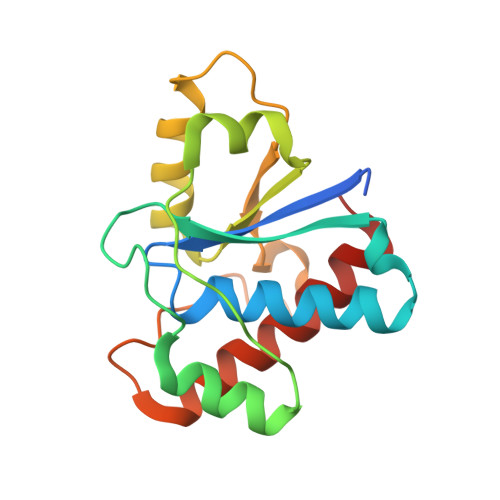Crystal structures of the apo form and a complex of human LMW-PTP with a phosphonic acid provide new evidence of a secondary site potentially related to the anchorage of natural substrates.
Fonseca, E.M., Trivella, D.B., Scorsato, V., Dias, M.P., Bazzo, N.L., Mandapati, K.R., de Oliveira, F.L., Ferreira-Halder, C.V., Pilli, R.A., Miranda, P.C., Aparicio, R.(2015) Bioorg Med Chem 23: 4462-4471
- PubMed: 26117648
- DOI: https://doi.org/10.1016/j.bmc.2015.06.017
- Primary Citation of Related Structures:
4Z99, 4Z9A, 4Z9B - PubMed Abstract:
Low molecular weight protein tyrosine phosphatases (LMW-PTP, EC 3.1.3.48) are a family of single-domain enzymes with molecular weight up to 18 kDa, expressed in different tissues and considered attractive pharmacological targets for cancer chemotherapy. Despite this, few LMW-PTP inhibitors have been described to date, and the structural information on LMW-PTP druggable binding sites is scarce. In this study, a small series of phosphonic acids were designed based on a new crystallographic structure of LMW-PTP complexed with benzylsulfonic acid, determined at 2.1Å. In silico docking was used as a tool to interpret the structural and enzyme kinetics data, as well as to design new analogs. From the synthesized series, two compounds were found to act as competitive inhibitors, with inhibition constants of 0.124 and 0.047 mM. We also report the 2.4Å structure of another complex in which LMW-PTP is bound to benzylphosphonic acid, and a structure of apo LMW-PTP determined at 2.3Å resolution. Although no appreciable conformation changes were observed, in the latter structures, amino acid residues from an expression tag were found bound to a hydrophobic region at the protein surface. This regions is neighbored by positively charged residues, adjacent to the active site pocket, suggesting that this region might be not a mere artefact of crystal contacts but an indication of a possible anchoring region for the natural substrate-which is a phosphorylated protein.
- Laboratory of Structural Biology and Crystallography, Institute of Chemistry, University of Campinas, CP 6154, 13083-970, Campinas, SP, Brazil.
Organizational Affiliation:



















